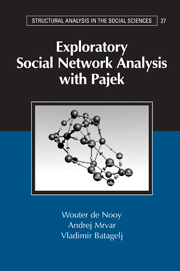Book contents
- Frontmatter
- Contents
- List of Illustrations
- List of Tables
- Preface
- Part I Fundamentals
- Part II Cohesion
- 3 Cohesive Subgroups
- 4 Sentiments and Friendship
- 5 Affiliations
- Part III Brokerage
- Part IV Ranking
- Part V Roles
- Appendix 1 Getting Started with Pajek
- Appendix 2 Exporting Visualizations
- Appendix 3 Shortcut Key Combinations
- Glossary
- Index of Pajek Commands
- Subject Index
3 - Cohesive Subgroups
Published online by Cambridge University Press: 05 June 2012
- Frontmatter
- Contents
- List of Illustrations
- List of Tables
- Preface
- Part I Fundamentals
- Part II Cohesion
- 3 Cohesive Subgroups
- 4 Sentiments and Friendship
- 5 Affiliations
- Part III Brokerage
- Part IV Ranking
- Part V Roles
- Appendix 1 Getting Started with Pajek
- Appendix 2 Exporting Visualizations
- Appendix 3 Shortcut Key Combinations
- Glossary
- Index of Pajek Commands
- Subject Index
Summary
Introduction
Social networks usually contain dense pockets of people who “stick together.” We call them cohesive subgroups and we hypothesize that the people involved are joined by more than interaction. Social interaction is the basis for solidarity, shared norms, identity, and collective behavior, so people who interact intensively are likely to consider themselves a social group. Perceived similarity, for instance, membership of a social group, is expected to promote interaction. We expect similar people to interact a lot, at least more often than with dissimilar people. This phenomenon is called homophily: birds of a feather flock together.
In this chapter, we present a number of techniques to detect cohesive subgroups in social networks, all of which are based on the ways in which vertices are interconnected. These techniques are a means to an end rather than an end in themselves. The ultimate goal is to test whether structurally delineated subgroups differ with respect to other social characteristics, for instance, norms, behavior, or identity. Does the homophily principle work? May we conclude that a cohesive subgroup represents an emergent or established social group?
Example
In 1948, American sociologists executed a large field study in the Turrialba region, which is a rural area in Costa Rica (Latin America). They were interested in the impact of formal and informal social systems on social change. Among other things, they investigated visiting relations between families living in haciendas (farms) in a neighborhood called Attiro.
- Type
- Chapter
- Information
- Exploratory Social Network Analysis with Pajek , pp. 61 - 83Publisher: Cambridge University PressPrint publication year: 2005



